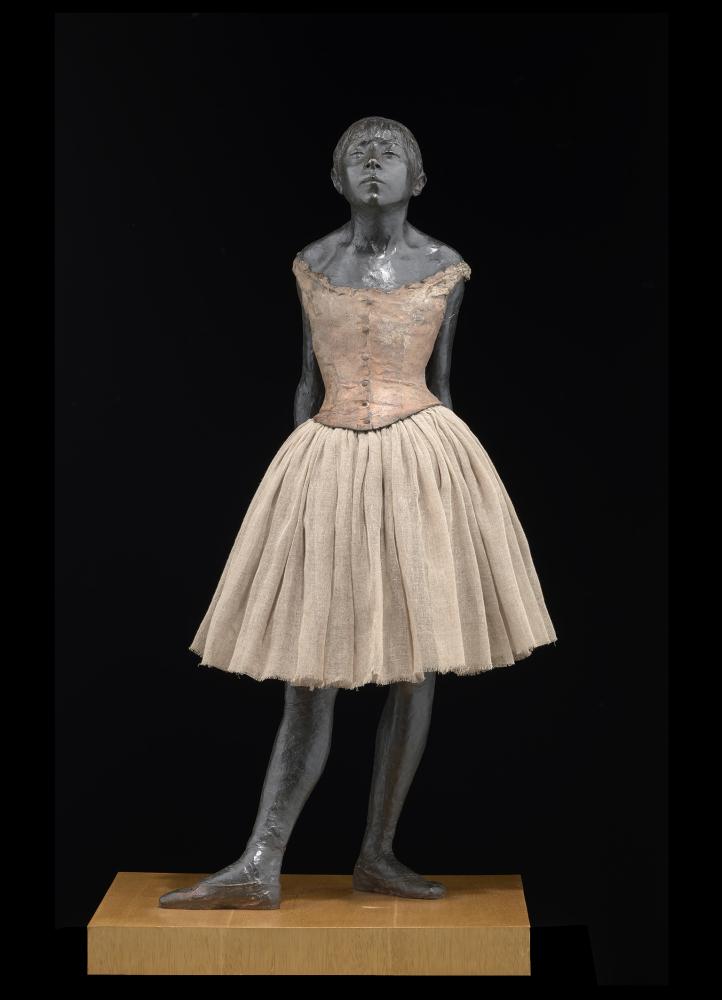The World's Most Famous Tutu: Restoration of Edgar Degas' "Little Fourteen-Year-Old Dancer"

After an extensive restoration process, Edgar Degas' "Little Fourteen-Year-Old Dancer" (circa 1880) will be back on display at the Albertinum of the Staatliche Kunstsammlungen Dresden (SKD) starting Tuesday, 8th August 2023. Edgar Degas' dancer is one of the iconic pieces in art history, and her ballet tutu is undoubtedly the most famous tutu in the world. During the restoration, the tutu was not only cleaned and conserved but also underwent retouching to fix any missing parts of the sculpture.
For decades, the "Little Fourteen-Year-Old Dancer" was part of the permanent exhibition at the Albertinum. Over time, its metallic surface had become dull, and some corrosion marks, particularly on the face, had become more pronounced. The temporary rearrangement of the exhibition space provided an opportunity to closely examine the sculpture in the restoration workshop of the SKD's sculpture collection.
In the process of assessing the damages, simultaneous art-technological investigations were carried out to address specific questions about the production techniques and materials used. The sculpture was also captured through photogrammetry, resulting in a 3D model. X-ray fluorescence analysis (XRF) revealed that the material used was brass, not bronze. Further material analyses were conducted in collaboration with the Archaeometric Laboratory of the Dresden Academy of Fine Arts (HfBK) to uncover the causes of the mysterious damages on the metal surface and the paint of the bodice. Additionally, the tutu, due to the deterioration of its material, had affected the underlying metal. The replacement for the original tutu, which was likely lost during World War II, was made in the 1960s using polyamide fibers (known as "Dederon" in the former German Democratic Republic).
During the restoration, a careful surface cleaning removed the grayish veil from the sculpture, and corrosion marks were reduced. The entire metallic surface was then conserved with a protective coating of microcrystalline wax. The numerous dark defects on the painted bodice were covered with retouches using reversible specialist colors.
The last and most apparent restoration measure involved the replacement of the old, damaging tutu. Creating the new tutu, hand-sewn by textile conservator Karen Klingbiel, presented a challenge for all involved. The well-known metal casts of the "Little Fourteen-Year-Old Dancer" have had multiple tutus replaced over the years, each one mostly based on the desolate state of the wax model found in Degas' studio. At that time, the once probably white tutu was heavily soiled and damaged, affecting its original length and shape significantly. As the actual appearance of the original tutu was not documented, the various existing variations worldwide reflect the range of ever-changing contemporary tastes and different aesthetic ideas – from long, short, and drooping tutus to satin and tulip skirts, to layered skirts in nearly black to brightly white.
Ultimately, there is no definitive guideline for the "correct" form, color, and length of the new tutus. To get closer to Degas' vision, other depictions of ballet dancers from his oeuvre were used. It became evident that the previous tutu did not match the artist's drawings and paintings. The new tutu is now longer than the previous one and closely resembles what the artist captured in his drawings and paintings. It also harmonizes in color with the dark patina of the body and the rosy tone of the bodice. The goal was to create a harmonious overall image in which the different materials come together, allowing the sculpture's great artistic quality to shine.
Edgar Degas (1834–1917), known primarily as a painter, was a self-taught sculptor. His most famous sculptural work, the "Little Fourteen-Year-Old Dancer," was also the only sculpture he publicly exhibited during his lifetime. When it was displayed for one day at the sixth Paris "Exhibition of Impressionists" in 1881, the artwork caused a scandal due to its realism. Degas created "the dancer" as a wax figure and adorned it with real attributes such as the ballet tutu, a real hair braid, and ballet shoes. The original sculpture is now in the National Gallery of Art in Washington. The materials used, which were previously associated with wax figure cabinets, caused a stir. Moreover, critics accused the artist of giving his dancer the ordinary features of a working-class child, which were perceived as ugly, vulgar, and provocative. In doing so, Degas broke with existing conventions in two ways. The criticism of his work led to him never exhibiting another sculpture during his lifetime.
Image : Little Fourteen-Year-Old Dancer, Edgar Degas copyright SKD
